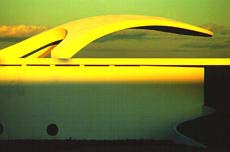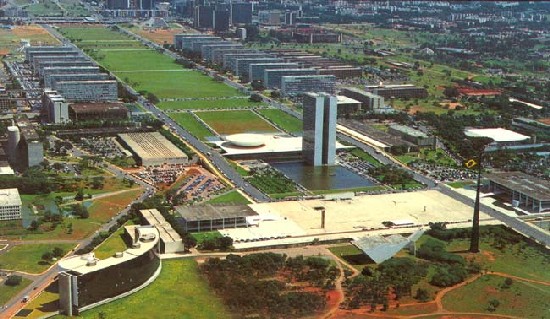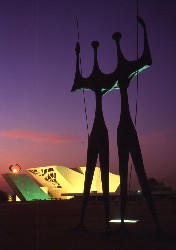Advertising by Google
Brasília, capital of Brazil
Area: 5.822 km2
Population: 2.051.146 inhab. (est. 2000).
The Federal District is completely surrounded by the State of Goiás. See map of Goiás.
Climate in Brasilia.
In the center of Brazilian's territory is one of the most originals cities of the world, Brasilia. It's created by Lúcio Costa architect and inaugurated in 1960, the federal capital is one of the few modernist urban projects that get rid of the small planks to become reality. It has a bird format in which the body and big open wings are two large perpendicular shafts (see the draft and actual photo of Pilot Plan of Brasilia).
Brasília was built in two thousand days to be the nation's focus of power. Inaugurated by ex-President Juscelino Kubitschek on April 21st, 1960, the Brazilian capital is the best known of the cities that were planned during the 20th century and is a landmark in contemporary town planning and modern architecture. The major players in the history of Brasília were ex-President Juscelino Kubitschek, who launched the competition to select the project for the new city and made huge efforts to see it built during his term, the town planner Lucio Costa, winner of the competition and creator of the Pilot Plan for Brasília, and the architect Oscar Niemeyer, responsible for the city's main architectural works.

Cathedral of Brasilia
Although it has been in existence for just under forty years, Brasília is the result of long-standing dreams. In 1823, its name had already been put forward by José Bonifácio to the General Constituent Assembly of the Empire which was considering installing the Federal Capital in the Brazilian interior.
As well as being that visionary's dream, the Brazilian capital was also inspired by the prophecy of a saint: in 1883, Dom João Bosco, a Salesian priest living in Turin, Italy, revealed that a new civilization would emerge in the centre of Brazil, somewhere between the 15th and 20th parallels. Believers of this prophecy created the Dom Bosco Community.
The new Federal District attracted workers from all the regions of Brazil; these were the so-called "candangos" (labourers) who were responsible for the building of the city. Twenty seven years after the inauguration of Brasília, the efforts of the thousands of workers involved were recognized by UNESCO when the city was declared as being a Heritage of Mankind in 1987.
Situated in the Centre-West region in an area ceded by the state of Goiás, Brasília is bordered by the Rivers Preto to the east and Descoberto to the west, bringing together in an area of 5,822 km2, a population of 2 million inhabitants. Living together democratically in the city's squared configuration are politicians of various persuasions, diplomats from the most far-flung countries and civil servants of all ranks. However, the fact of their living together does not remove the contrasts: the satellite towns where thousands live are advancing in a disorderly fashion around the Pilot Plan with its broad, tree-planted spaces, the distant horizon, the north and south lakes and the succession of arches and curves that form the architecture of the city.
Brasilia, Seat of Brazilian Government

JK Monument
The visitor to Brasília cannot miss visiting the Esplanada dos Ministérios and the Praça dos Três Poderes (Three Powers Square), location of National Congress (seat of legislative power), the Planalto Palace (head quarters of executive administration) and the Supreme Federal Court (judicial authority). These are often the subject of picture postcards that together with the Alvorada Palace, the Metropolitan Cathedral, the Palace of Justice and the Itamaraty Palace, amongst other buildings, have become tourist attractions.

Aerial view of Three Powers Square
The two buildings in the middle are where Senate and Chamber offices are located; the Plenarium of the Chamber is the visible white half-sphere; the Plenarium of the Senate is hidden behind the two buildings.
The flat building to the left of the Square is the Plenarium of the Supreme Court. The taller, dark building beside the court is where the offices of staff are located.
The building at the right hand side of the photo is the Planalto Palace, seat of Executive. The two lines of large buildings are the Ministries.
As a complement to the beauty of the architectural landscape, Brasília contains the highest concentration per square metre of works by the best-known Brazilian artists. This high density of works of art is on display in the gardens designed by Burle Marx which lend beauty to the official buildings; they take the form of statues by Ceschiatti, panels by Athos Bulcão, Di Cavalcanti's mural and Bruno Giorgio's sculptures which adorn the public buildings. Centre stage for Brazil's major political decisions, the Federal Capital also has 24 museums that tell its own story and trace Brazil's course through history. Most notable amongst these museums are the JK Memorial Museum, the Catetinho Museum, the Museum of the Indian and the Museum of North-Eastern Arts and Traditions.

Three Powers Square
Much more than just a parade of palaces and works of art, Brasília is also a magical discovery because of the beauty of the natural world that surrounds it - the cerrado, with its twisted trees, the hidden waterfalls, grottoes, lakes, natural swimming pools, caverns and nature trails that constantly surprise the visitor with their rare species of fauna and flora. A total of 42% of the territory of the Federal District is of environmental protection areas.
Amongst these natural attractions is the Brasília National Park which includes the basins of the Rivers Torto and Bananal with landscapes formed by open country, scrublands and ciliary forests, as well as two mineral water swimming-pools with excellent supporting services. It is an environmental reserve with a museum containing local species of fauna and flora. A little further away from the centre of the Federal Capital is the Poço Azul ("Blue Pool") with its clear blue waters forming a pool contained in a rock of quartz; there is also the Mumunhas waterfall with its natural swimming pools and rocky profile. Both of these are situated in the Cafuringa Environmental Protection Area which contains a total of nine caves and grottoes.
Read more:
 Federal District official site. Maintained by the government of the Federal District of Brazil.
Federal District official site. Maintained by the government of the Federal District of Brazil.
 Brasilia. In English.
Brasilia. In English.
 Guia BSB. Brasilia guide, mostly commercial info.
Guia BSB. Brasilia guide, mostly commercial info.
 University of Brasilia. One of the best Brazilian Universities.
University of Brasilia. One of the best Brazilian Universities.
Back to Top